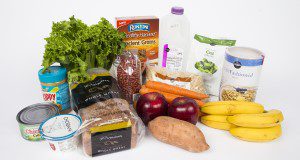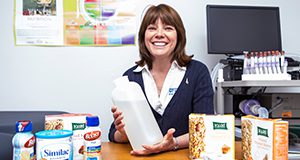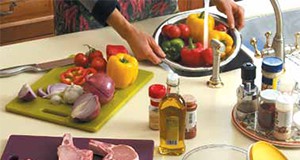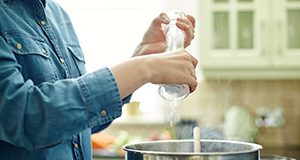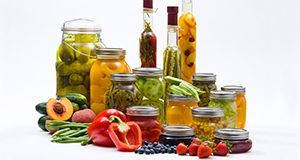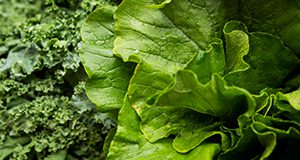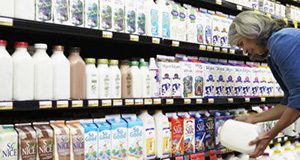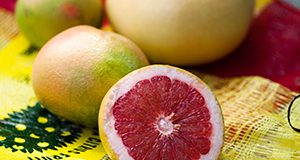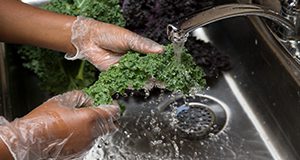 El lavado de manos es uno de los principales métodos utilizados para ayudar a prevenir enfermedades transmitidas por los alimentos. El lavado adecuado de las manos reducirá el riesgo de transmitir microorganismos, como bacterias, virus y otros agentes, que causan enfermedades a las personas que comen los alimentos que manipulas. Si necesita usar desinfectante para las manos, ¡siempre lávate las manos primero! La suciedad, los alimentos o cualquier otra cosa en las manos hacen menos eficaz el efecto del alcohol. ¡No use desinfectante para manos en lugar de lavarse las manos! This is the Spanish language version of Proper Hand Washing for Food Handlers (FCS8784Eng/FY726).
El lavado de manos es uno de los principales métodos utilizados para ayudar a prevenir enfermedades transmitidas por los alimentos. El lavado adecuado de las manos reducirá el riesgo de transmitir microorganismos, como bacterias, virus y otros agentes, que causan enfermedades a las personas que comen los alimentos que manipulas. Si necesita usar desinfectante para las manos, ¡siempre lávate las manos primero! La suciedad, los alimentos o cualquier otra cosa en las manos hacen menos eficaz el efecto del alcohol. ¡No use desinfectante para manos en lugar de lavarse las manos! This is the Spanish language version of Proper Hand Washing for Food Handlers (FCS8784Eng/FY726).
https://edis.ifas.ufl.edu/fy1488
Category: Health & Nutrition
Adecuado lavado de manos para adultos mayores
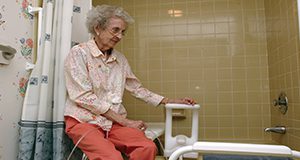 Lavarse las manos es una forma importante de reducir la propagación de enfermedades infecciosas. Los gérmenes de origen humano y animal pueden transmitirse a las manos, que a su vez pueden transmitir los gérmenes a otras personas, alimentos y cualquier otra cosa que toquen. El adecuado lavado de las manos puede reducir la cantidad de microorganismos infecciosos en nuestras manos y reducir el riesgo de contraer algunas enfermedades. This is the Spanish language version of Proper Hand Washing for Elders (FCS8785Eng/FY727).
Lavarse las manos es una forma importante de reducir la propagación de enfermedades infecciosas. Los gérmenes de origen humano y animal pueden transmitirse a las manos, que a su vez pueden transmitir los gérmenes a otras personas, alimentos y cualquier otra cosa que toquen. El adecuado lavado de las manos puede reducir la cantidad de microorganismos infecciosos en nuestras manos y reducir el riesgo de contraer algunas enfermedades. This is the Spanish language version of Proper Hand Washing for Elders (FCS8785Eng/FY727).
https://edis.ifas.ufl.edu/fy1489
Meal Planning for Adults with Diabetes
Nutrition, physical activity, and medication are the three main components of a diabetes management plan. According to the Americans Diabetes Association, there is no one diabetes meal plan; rather, it is a healthful eating pattern specifically designed to meet your individual needs. This new 2-page publication of the UF/IFAS Food Science and Human Nutrition Department provides some basic tips for creating a personalized meal plan for adults with diabetes. Written by Nancy J. Gal and Wendy J. Dahl.
https://edis.ifas.ufl.edu/fs323
Diabetes Meal Planning: Managing Your Carbohydrate Intake
If you have diabetes, maintaining a consistent carbohydrate intake throughout the day is an effective meal-planning method to help maintain your target blood glucose levels. Foods that contain carbohydrates have the greatest effect on blood glucose levels compared to foods that contain primarily protein or fat. Carbohydrates in foods that contribute to blood glucose includes sugars and starches. The amount of carbohydrate you consume is based on your diabetes treatment goals and carbohydrate tolerance. This new 3-page publication of the UF/IFAS Food Science and Human Nutrition Department, written by Nancy J. Gal and Wendy J. Dahl, provides a strategy for planning your daily menu to manage your carbohydrate intake.
https://edis.ifas.ufl.edu/fs324
Fibra alimentaria y enfermedades crónicas
La fibra alimentaria tiene muchos efectos positivos en la salud. Esta publicación describe las relaciones entre la fibra alimentaria y la prevención y el tratamiento de enfermedades crónicas.
This new 2-page publication of the UF/IFAS Food Science and Human Nutrition Department is a Spanish translation of FSHN18-11/FS314, Dietary Fiber and Chronic Disease. Written by Wendy Dahl and translated by Daniela Rivero Mendoza.
https://edis.ifas.ufl.edu/fs322
Bebidas nutricionales suplementarias: Las necesito?
Las bebidas nutricionales suplementarias a menudo se usan en hospitales y hogares de adultos para ayudar a nutrir a quienes pueden comer mal y han perdido peso debido a una enfermedad o falta de apetito. Más recientemente, las bebidas nutricionales están disponibles para la compra de los consumidores. Ejemplos de bebidas o batidos nutricionales suplementarios comunes son Ensure® y Boost®. Esta publicación explora la pregunta que muchos adultos mayores se hacen: “¿Necesito bebidas nutricionales suplementarias?”
This new 3-page publication of the UF/IFAS Food Science and Human Nutrition Department is a Spanish translation of FSHN18-12/FS315, Supplemental Nutrition Drinks: Do I Need Them? Written by Claire Marie Fassett, Nancy J. Gal, and Wendy J. Dahl, and translated by Daniela Rivero Mendoza.
https://edis.ifas.ufl.edu/fs321
¿Cuantas comidas debo comer cada dia?
Comer de manera saludable no se trata tanto de la cantidad de comidas y meriendas consumidas, sino de los tipos y las cantidades de alimentos totales consumidos en un día. Tratar de cumplir con las porciones recomendadas de los cinco grupos de alimentos, es decir, frutas, verduras, granos, proteínas y productos lácteos ayudará a promover la buena salud y prevenir enfermedades.
This new 2-page publication of the UF/IFAS Food Science and Human Nutrition Department is the Spanish translation of FSHN18-10/FS313, How many meals should I eat each day? Written by Zainab Alyousif and Wendy Dahl, and translated by Daniela Rivero Mendoza.
https://edis.ifas.ufl.edu/fs319
Sal: ¿Debo recortar su consumo?
La sal alimentaria está compuesta de sodio y cloruro, dos minerales esenciales necesarios para una buena salud. El sodio es muy importante para nuestro cuerpo para mantener el equilibrio de líquidos, el volumen de sangre y la presión arterial. Sin embargo, muchas personas consumen más sodio en la dieta (de la sal) que lo que se necesita. La disminución de sodio en la dieta ha recibido mucha atención en los últimos años debido a la asociación del alto consumo de sodio en la dieta con hipertensión (presión arterial alta) y enfermedad cardiovascular. Esta publicación explora los efectos en la salud de la ingesta excesiva de sodio y las formas de disminuir la ingesta de este mineral.
This new 3-page publication of the UF/IFAS Food Science and Human Nutrition Department is the Spanish version of FSHN 18-9/FS312: Salt: Should I Cut Back? Written by Asmaa Fatani, Nancy J. Gal, and Wendy J. Dahl, and translated by Daniela Rivero Mendoza.
https://edis.ifas.ufl.edu/fs320
Preventing Foodborne Illness: Yersiniosis
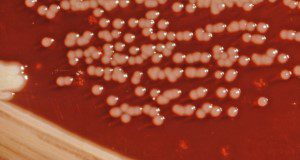 Yersiniosis is an infectious disease caused by the bacterium Yersinia and is typically associated with the consumption of contaminated food or liquids. Yersiniosis is characterized by common symptoms of gastroenteritis such as abdominal pain and mild fever. The bacterium is prevalent in the environment, enabling it to contaminate water and food systems. Outbreaks of yersiniosis have been associated with improperly pasteurized milk, ready-to-eat salad mix, oysters, and more commonly with consumption of undercooked meals containing pork. Yersiniosis incidents have been reported frequently in Northern Europe, Scandinavia, and Japan, and rarely in the United States. However, the reported low incidence of Yersinia in the US food supply may be underestimated due to the long incubation time and misdiagnosis of patients with Y. enterocolitica infections, along with the inability to identify the source of infection and the fact that only serious cases are reported. This 4-page major revision, written by Christopher Pabst, Jaysankar De, Aswathy Sreedharan, Correy Jones, and Keith R. Schneider and published by the UF/IFAS Food Science and Human Nutrition Department, also describes long-term effects and complications of yersiniosis, members of the population most at risk, and prevention methods.
Yersiniosis is an infectious disease caused by the bacterium Yersinia and is typically associated with the consumption of contaminated food or liquids. Yersiniosis is characterized by common symptoms of gastroenteritis such as abdominal pain and mild fever. The bacterium is prevalent in the environment, enabling it to contaminate water and food systems. Outbreaks of yersiniosis have been associated with improperly pasteurized milk, ready-to-eat salad mix, oysters, and more commonly with consumption of undercooked meals containing pork. Yersiniosis incidents have been reported frequently in Northern Europe, Scandinavia, and Japan, and rarely in the United States. However, the reported low incidence of Yersinia in the US food supply may be underestimated due to the long incubation time and misdiagnosis of patients with Y. enterocolitica infections, along with the inability to identify the source of infection and the fact that only serious cases are reported. This 4-page major revision, written by Christopher Pabst, Jaysankar De, Aswathy Sreedharan, Correy Jones, and Keith R. Schneider and published by the UF/IFAS Food Science and Human Nutrition Department, also describes long-term effects and complications of yersiniosis, members of the population most at risk, and prevention methods.
http://edis.ifas.ufl.edu/fs193
Facility Registration and Initial Regulatory Compliance Activities for Acidified Food and Low-Acid Canned Food Processors in Florida
Food businesses are subject to a wide range of regulatory requirements. Food entrepreneurs who want to produce and sell acidified foods or low-acid canned foods must abide by specific FDA regulations. This new 3-page document intends to clarify the initial steps food entrepreneurs must implement to comply with these regulations. This factsheet is one in a Food Entrepreneurship in Florida series, which assists beginning and established food entrepreneurs by providing them information on topics highly relevant to starting and running a food business: regulations, safety, labeling, processing, and marketing. Written by Matthew Krug and Soohyoun Ahn, and published by the UF/IFAS Food Science and Human Nutrition Department, February 2019.
http://edis.ifas.ufl.edu/fs318
Feeding Your Baby
Feeding your baby is one of the first things you do as a parent. It is also one of the ways that you develop a relationship with this new family member. When feeding goes well, everyone in the family is happier. This 3-page publication can help you develop a close feeding relationship with your baby. The skills you learn will also help you and your child avoid conflicts over food during the toddler and preschool years. Written by Linda B. Bobroff and Nicole Owens Duffy, and published by the UF/IFAS Department of Family, Youth and Community Sciences, revised March 2019.
http://edis.ifas.ufl.edu/he964
Alimentacion Saludable: Organice Su Plato
Planear sus comidas puede ayudar a controlar las porciones y la cantidad de carbohidratos que usted consume a través del día. Esto es especialmente importante si usted padece de la diabetes o si usted es una persona en alto riesgo de padecer de la diabetes. This 2-page document is the Spanish version of Healthy Eating: Create Your Plate. Written by Jennifer Hillan and Linda B. Bobroff, and published by the UF/IFAS Department of Family, Youth and Community Sciences, revised December 2018.
http://edis.ifas.ufl.edu/fy907
Lactose Intolerance: What Consumers Need to Know
Lactose intolerance can be an uncomfortable, inconvenient condition with a variety of causes and treatments. This 3-page document will provide guidance for consumers so that they may find the right information to help them manage this condition. Written by Matt Krug and Amy Simonne and published by the UF/IFAS Department of Food Science and Human Nutrition, November 2018.
http://edis.ifas.ufl.edu/fs316
Healthy Living: Monitoring Your Blood Pressure at Home
Do you think your blood pressure may be too high? Have you been diagnosed with high blood pressure? In either case, it is recommended that you monitor your blood pressure at home and get it checked at the doctor's office. This 4-page document discusses how to monitor your blood pressure at home. Written by Linda B. Bobroff, and published by the UF/IFAS Department of Family, Youth and Community Sciences, revised November 2018.
http://edis.ifas.ufl.edu/fy1126
Alimentacion Saludable: Liquidos
Más de la mitad del peso del cuerpo humano adulto es agua. El agua transporta nutrientes a las células en nuestros cuerpos y remueve los residuos. Nuestros cuerpos no podrían funcionar sin una fuente de agua adecuada. This 2-page fact sheet discusses the importance of water, effects of dehydration, implications for older persons, suggested fluid intake, and ways to include more water in one’s diet. It is the Spanish version of Healthy Eating: Fluids. Written by Linda B. Bobroff, Luisa Oliver-Cordero, and Emily Minton, and published by the UF/IFAS Department of Family, Youth and Community Sciences, revised September 2018.
http://edis.ifas.ufl.edu/fy071
Alimentacion Saludable: Bebidas saludables
Los batidos son una manera deliciosa de incorporar más frutas y nutrientes a su dieta. This 2-page fact sheet provides tasty recipes for shakes and smoothies. It is the Spanish version of Healthy Eating: Drink to Your Health. Written by Jennifer Hillan, Emily Minton, and Linda B. Bobroff, and published by the UF/IFAS Department of Family, Youth and Community Sciences, revised September 2018.
http://edis.ifas.ufl.edu/fy697
Supplemental Nutrition Drinks: Do I Need Them?
Supplemental nutrition drinks are often used in hospitals and adult care homes to help nourish those who may be eating poorly. More recently, these drinks have become available for purchase by consumers. This 2-page publication explores the question that many older adults ask: “Do I need supplemental nutrition drinks?” Written by Claire Marie Fassett, Nancy J. Gal, and Wendy J. Dahl and published by the UF/IFAS Department of Food Science and Human Nutrition, August 2018.
http://edis.ifas.ufl.edu/fs315
How Many Meals Should I Eat Each Day?
For older adults who want to stay healthy, it’s a common question: should I eat three meals a day, or is two adequate? Also, how much should I snack? This 2-page publication discusses the appropriate amount of daily food consumption in older adults. Written by Wendy J. Dahl and Zainab Alyousif and published by the UF/IFAS Department of Food Science and Human Nutrition, August 2018.
http://edis.ifas.ufl.edu/fs313
The Health Benefits of Grapefruit Furanocoumarins
Grapefruits are known for their numerous health benefits, specifically anti-inflammatory, anti-cancer, anti-obesity, and bone-building effects that are the result of natural chemicals called furanocoumarins. This 4-page document discusses the health benefits of grapefruit furanocoumarins. Written by Yu Wang and Laura Reuss and published by the UF/IFAS Department of Food Science and Human Nutrition, August 2018.
http://edis.ifas.ufl.edu/fs311
Dietary Fiber and Chronic Disease
Dietary fiber supports health in various ways. This 2-page document describes the relationships between dietary fiber and prevention and treatment of chronic disease. Written by Wendy J. Dahl and published by the UF/IFAS Department of Food Science and Human Nutrition, August 2018.
http://edis.ifas.ufl.edu/fs314

